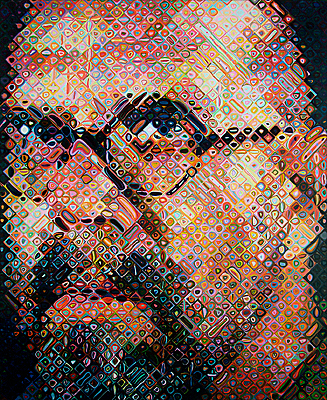CHUCK CLOSE is an American artist who achieved monumental fame as a photorealist. Though a catastrophic spinal artery collapse in 1988 left him severely paralyzed, he has continued to produce work which remains sought after by museums and collectors.
His genius was recognized early on in his career. In 1969 his work was included in the Whitney Biennial followed by his first one-man show in 1970. Shortly thereafter his work was first exhibited at the New York MOMA in early 1973. At this time, he often worked from photographic stills to create paintings that appeared to be photographs.
THE EVENT that changed his life occurred on Dec. 7, 1988. Following an abbreviated speech giving an art award Close felt a strange pain in his chest and then ran to the hospital. Within a few hours, he was paralyzed from the neck down. At first the doctors were confused but eventually they diagnosed a rare spinal artery collapse. Close calls that day, "The Event" and now relies on a wheelchair, presumably for the rest of his life. At the time, doctors and art experts both agreed, his career was over.
Close, however, had other ideas and he continued to paint with a brush strapped onto his fingers, creating large portraits in low-resolution grid squares. Viewed from afar, these squares appear as a single, unified image which attempt photo-reality, albeit in pixilated form. Typically, each square within the grid is filled with roughly executed regions of color (usually consisting of painted rings on a contrasting background) which give the cell a perceived 'average' hue which makes sense from a distance. Later work has branched into non-rectangular grids - regions of similar colors, color grid work, and larger grids to make the cell by cell nature of his work obvious even in small reproductions. Although the paralysis restricted his ability to paint as meticulously as before, Close has proved able to create his desired effects even with the most difficult situation and materials to control.

